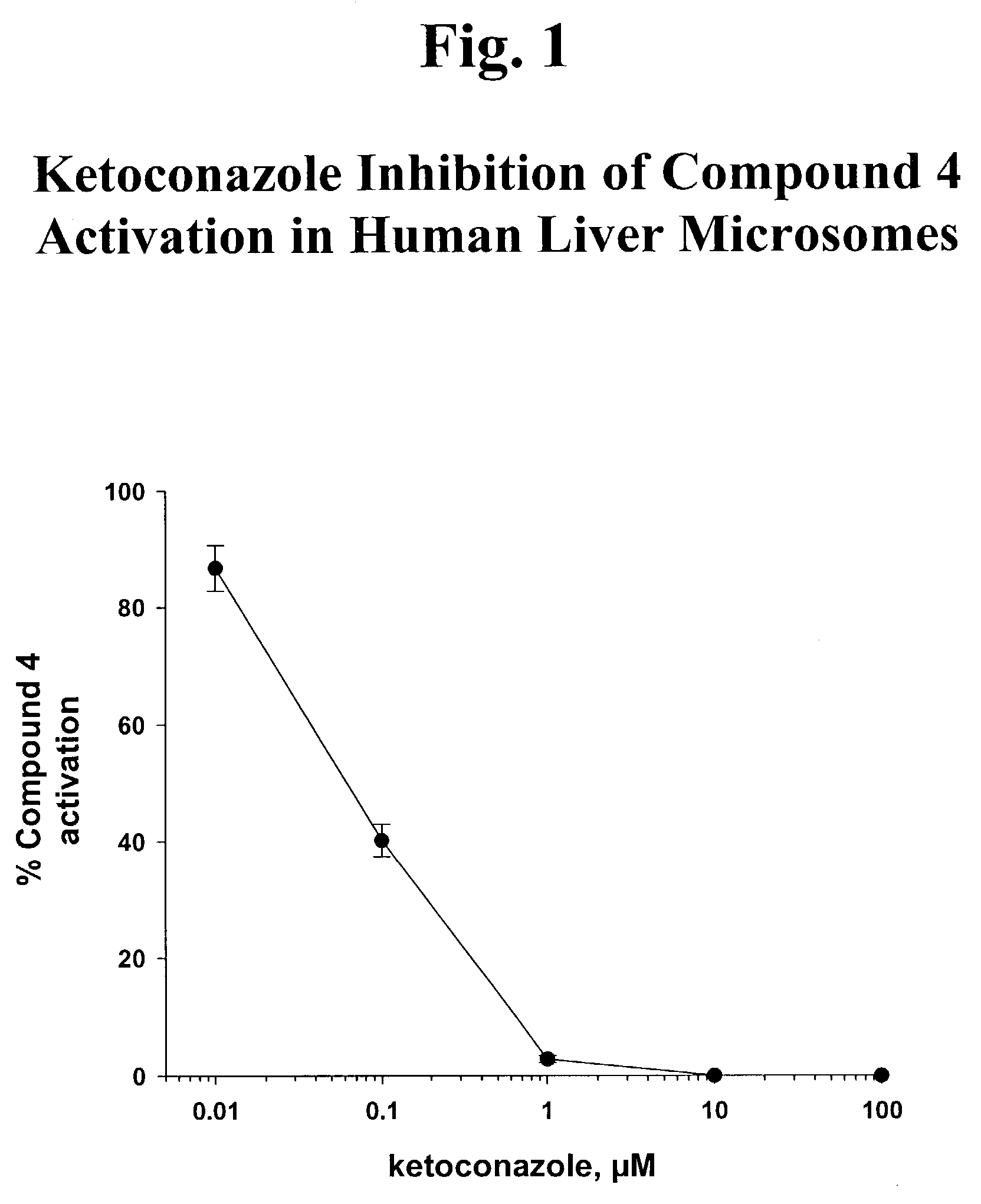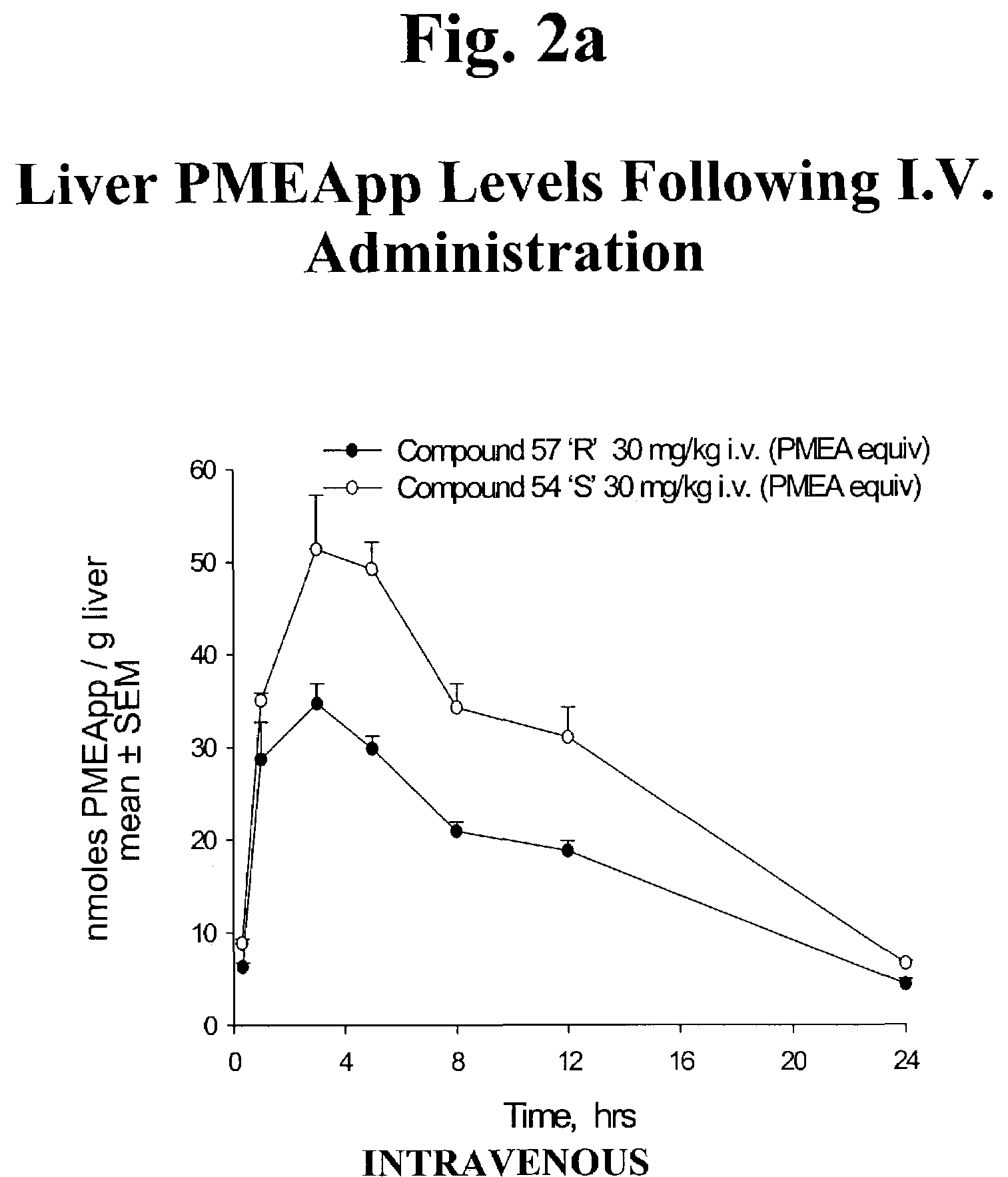Phosphonic acid based prodrugs of PMEA and its analogues
- Summary
- Abstract
- Description
- Claims
- Application Information
AI Technical Summary
Benefits of technology
Problems solved by technology
Method used
Image
Examples
example 1
Preparation of 1-(2′-Furanyl) Propane-1,3-Diol via Grignard Addition and Hydroboration
[0285]To a solution of 2-furaldehyde (3 g, 31.2 mmol) in THF (60 mL) was added 1M vinyl magnesium bromide in THF (34 mL) at 0° C. After stirring for an hour, a solution of 1M BH3 THF complex in THF was added. The reaction was quenched with 3N NaOH (20 mL) and 30% hydrogen peroxide (10 mL) at 0° C. The organic fraction was separated and concentrated. The crude product was chromatographed by eluting with 5% methanol-dichloromethane to give 1-(2′-furyl)propane-1,3-diol (1 g, 22%).
example 2
Preparation of 1-(2′-Pyridyl) Propane-4,3-Diol via Benzylic Oxidation
Step A: (J. Org. Chem. 22:589 (1957))
[0286]To a solution of 3-(2′-pyridyl)propane-1-ol (10 g, 72.9 mmol) in acetic acid (75 mL) was added 30% hydrogen peroxide slowly. The reaction mixture was heated to 80° C. for 16 h. The reaction was concentrated under vacuum and the residue was dissolved in acetic anhydride (100 mL) and heated at 110° C. overnight. Acetic anhydride was evaporated upon completion of the reaction. Chromatography of the mixture by eluting with methanol-methylene chloride (1:9) resulted in 10.5 g (60%) of pure diacetate.
Step B:
[0287]To a solution of diacetate (5 g, 21.1 mmol) in methanol-water (3:1, 40 mL) was added potassium carbonate (14.6 g, 105.5 mmol). After stirring for 3 h at room temperature, the reaction mixture was concentrated. The residue was chromatographed by eluting with methanol-methylene chloride (1:9) to give 2.2 g (68%) of crystalline diol.
example 3
Preparation of 1-(Aryl)-Propane-1,3-Diol from Propane-1,3-Diol via Grignard Addition
Step A: (J. Org. Chem. 53:911 (1988))
[0288]To a solution of oxalyl chloride (5.7 mL, 97 mmol) in dichloromethane (200 mL) at −78° C. was added dimethyl sulfoxide (9.2 mL, 130 mmol). The reaction mixture was stirred at −78° C. for 20 min before addition of 3-(benzyloxy)propan-1-ol (11 g, 65 mmol) in dichloromethane (25 mL). After an hour at −78° C., reaction was quenched with triethylamine (19 mL, 260 mmol) and warmed to room temperature. Work-up and column chromatography by elution with dichloromethane resulted in 8 g (75%) of 3-(benzyloxy)propan-1-al.
Step B:
[0289]To a solution of 3-(benzyloxy)propan-1-al (1 g, 6.1 mmol) in THF at 0° C. was added a 1M solution of 4-fluorophenylmagnesium bromide in THF (6.7 mL, 6.7 mmol). The reaction was warmed to room temperature and stirred for 1 h. Work-up and column chromatography by elution with dichloromethane resulted in 0.7 g (44%) of alcohol.
Step C:
[0290]To ...
PUM
| Property | Measurement | Unit |
|---|---|---|
| Fraction | aaaaa | aaaaa |
| Temperature | aaaaa | aaaaa |
| Temperature | aaaaa | aaaaa |
Abstract
Description
Claims
Application Information
 Login to View More
Login to View More - R&D
- Intellectual Property
- Life Sciences
- Materials
- Tech Scout
- Unparalleled Data Quality
- Higher Quality Content
- 60% Fewer Hallucinations
Browse by: Latest US Patents, China's latest patents, Technical Efficacy Thesaurus, Application Domain, Technology Topic, Popular Technical Reports.
© 2025 PatSnap. All rights reserved.Legal|Privacy policy|Modern Slavery Act Transparency Statement|Sitemap|About US| Contact US: help@patsnap.com



